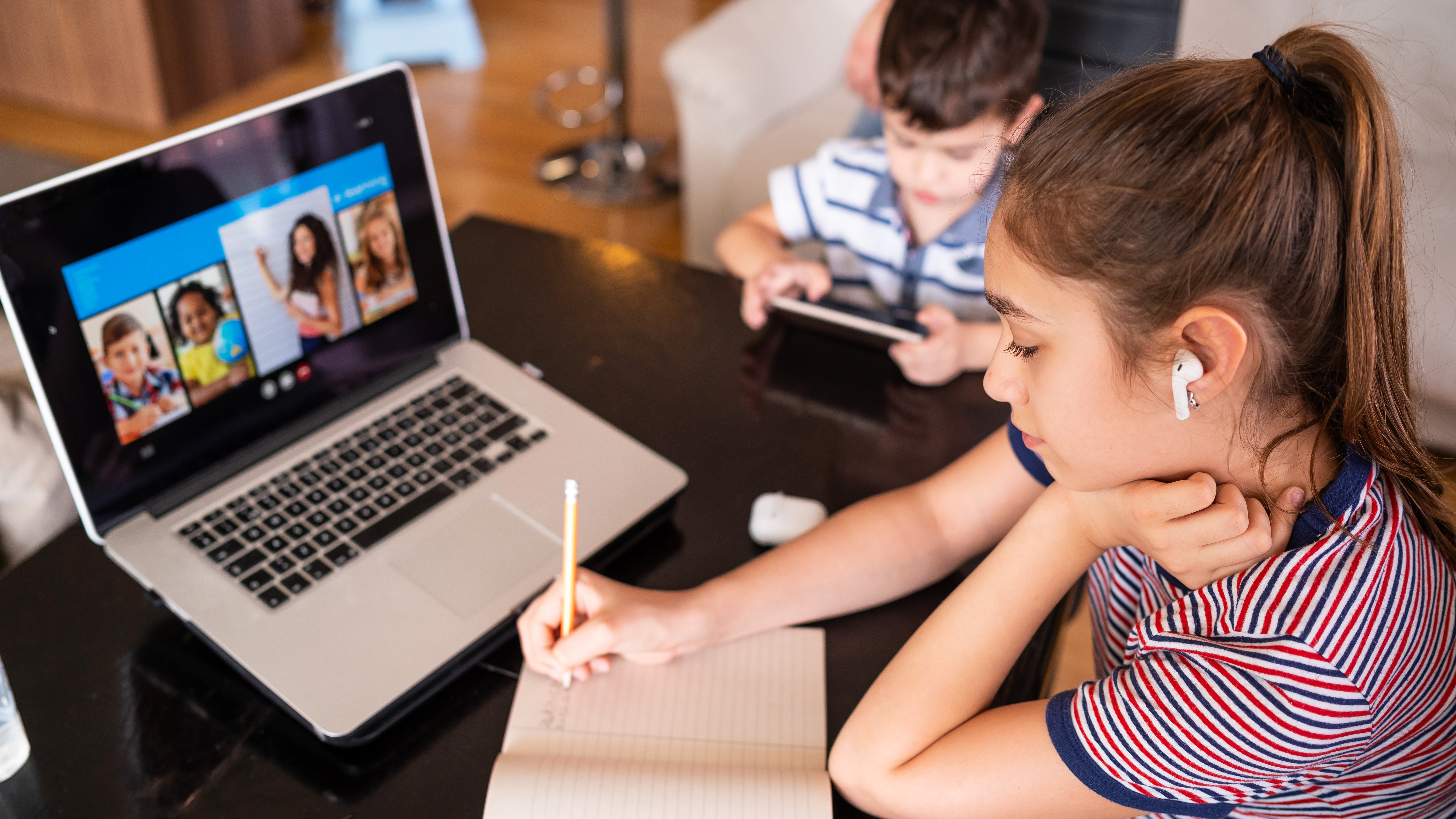
DOWNLOAD
DATE
Related Industries
Contact
An opportunity to establish a sustainable digital education system
Life during the global COVID-19 pandemic has been difficult for parents and children alike, as their normal everyday routines were upended. At its peak, school closures impacted around 1.6 billion learners in 190 countries worldwide, leading to the rapid, sudden expansion of digital learning. Although approaches to education in the COVID-19 era have varied worldwide, many school systems have turned to digital tools to mitigate the negative impact school closures have had on individual students and on society at large. Some prevailing questions have emerged: How can governments, schools, and education companies use the experiences gained with remote learning to establish a high-quality hybrid learning system in the long term? Most importantly, how can society be ensured that such a system will offer equitable access for all students?
COVID-19 accelerates digitalization in schools
Efforts to ensure uninterrupted learning are crucial. To illustrate, a two-months-long teacher strike in Belgium in the 1990s resulted in affected students being more likely to repeat a grade and less likely to complete higher education compared to students who could continue their education uninterrupted. For society as a whole, there is also a significant financial impact resulting from school closures. A recent OECD report, “The Economic Impacts of Learning Losses,” estimates the societal cost of school closures to be a 1.5% lower global GDP for the next century. In Norway, as reported in The Economist, it is estimated that the country’s school shutdowns cost €150 per student each day, based on how much less today’s students will earn in the future due to their education being put on hold or having become of lower quality. The rest is lost parental productivity from caring for children while working from home. In this context, the availability of digital tools has lowered the negative impact of the COVID-19 crisis on schools overall, yet results across European countries vary wildly. For example, while countries such as Germany and Austria struggled with the rapid shift to remote learning this past year due to their limited previous experiences, Finland was able to rely on its long-established and tested digital education system.
Success of digital education requires not only available technical infrastructure at a student’s home, but, more importantly, the right digital pedagogical skills and effective student-parentteacher communication. Interestingly, according to the German School Portal, only 53% of German teachers used some form of digital tools before COVID-19, and 66% think that their schools were not prepared for remote learning due to insufficient technical infrastructure and skills.
Going forward, governments, schools, and education companies can use the COVID-19 crisis as a catalyst to remote learning and technology use, including adaptive learning platforms. Certainly, the shift toward remote learning poses an opportunity for countries to accelerate digital transformation within their school systems, which leads to better performance. Indeed, students attending classes making pedagogically effective use of digital tools show significantly better performance in both mathematics and languages, according to the OECD’s Programme for International Student Assessment (PISA), an “international assessment that measures 15-year-old students’ reading, mathematics, and science literacy every three years.” Moreover, differences among high- and low-performing students and genders decrease. Countries, however, are at different stages regarding digital learning (see figure below). Furthermore, attendance rates have increased during the pandemic, with Sweden seeing a 35% higher attendance rate when switching to remote learning compared to pre-pandemic levels. (Source: OECD) This highlights that the school of tomorrow can and will be increasingly digital.

Making the transition from remote learning to digital learning
During this year of profound tragedy and upheaval, there have been a few silver linings, such as the wide range of activities that have moved online quickly. For some countries, the crisis accelerated their already-in-progress transition to digital learning through the fast implementation of short-term initiatives. The Korean government, for example, introduced online science classes during the COVID-19 school closures. Students can watch video-based learning content while teachers monitor their learning progress and provide feedback accordingly.
Countries that had not implemented digital education on a larger scale before the pandemic often managed to get the hardware and software in place quickly but were still struggling with the new ways of teaching. To properly adapt to an online platform for the long term, teachers must rethink in-person education and transform it to a hybrid offering. This includes classroom experience, communications, and post-lesson work in physical, digital, or blended environments.
The classroom experience has gained a lot of attention during the COVID-19 crisis, and several technology companies have offered enhanced and even new solutions, enabling teachers to present and share information online. However, given the short attention span of students, traditional hour-long lessons need to be substituted with shorter, more frequent, bite-sized lessons that students can quickly grasp and later test their knowledge on with targeted quizzes. The latest PISA report suggests that the optimal time a student should use a digital device is less than 60 minutes per subject per week. So physical and online learning materials should be used alternately to bring the hybrid model to reality. Another trend that has been accelerating since the pandemic, albeit in low numbers, is adaptive learning platforms, which adjust learning phases based on student performance. Such tools have been seen mostly as extracurricular support but will soon find their way into standard teaching material.
Integrating social interaction in the digital learning process is key. A pedagogical method developed in Sweden that focuses on real-time feedback and assessment from teachers and among students through the means of shared forums is yielding significantly higher learning outcomes than other digitally supported classes. Moreover, digital games can be used to increase student engagement and make education more interactive. These learning games need to be designed to follow students’ unique learning progress as they overcome challenges and in turn improve their skills. For instance, the city of Helsinki has introduced a variety of learning games in primary schools (e.g., a game using geographical data encourages students to identify plants and animals while being outdoors). Results show that students using learning games are more motivated and the tools improve teamwork. Finland is also increasingly using games in educational contexts in connection with the growing importance of learning analytics and augmented reality/virtual reality solutions. (Source: Eurisy)
Communication with students using digital tools is a process that must be learned by students and teachers alike. Several multimedia conferencing tools have been developed to allow for one-on-one interactions with students and parents (e.g., Zoom). However, to succeed, the right communication processes for each situation need to be developed. Teacher-parent communication, for instance, differs wildly from educational settings and must be offered with appropriate tools (e.g., feedback, school news, and day-to-day updates).
Finally, post-lesson work is very important. Ensuring that all students follow along and get the support they need is critical. Clearly, low-income families are struggling to provide the same support as higher-income families, and this is where government programs play a key role. Enabling online support channels – where students can ask questions regarding their homework as well as information channels to keep parents updated about homework and upcoming tests – is critical for digital learning. Also, including parents in the pedagogical process with easy-toaccess information regarding student status is another step to enhance post-lesson work.
Framework for successful digital education
To help governments and schools around the world adapt to the new normal post–COVID-19, Arthur D. Little has developed a framework to enable a sustainable long-term transition to digital learning, covering specific requirements when it comes to governance, culture, pedagogy, and infrastructure/technology (see figure below). Core to this framework is the resulting impact from this transition to digital learning on the performance of students, teachers, the schooling system, and, broadly, the national education system:

- Governance. A holistic approach to digital learning on both a national and city level needs to be taken to ensure the appropriate allocation of investments. A digital education strategy identifying key objectives and principles provides a basis to align stakeholder efforts (see Vienna case study). Defining concrete KPIs for each strategic dimension establishes commitment and facilitates implementation. On a country level, curriculums need to enable digital education and be adapted to digital skills. Digital skills must have the same importance as oral, reading, writing, and math skills in the curriculum and should be measured in a common framework. Another key aspect is data governance, which is becoming increasingly important with the establishments of laws such as GDPR in the EU and the Clarifying Lawful Overseas Use of Data (CLOUD Act) in the US. Data governance principles need to guide the choice of learning tools and solutions.
- Culture. City or schools must foster a culture of change to adapt to digital education. This begins with the acceptance of digital tools amongst teachers. By including stakeholders early in the digitalization journey, larger buy-in and a sense of trust will be established. The second step is to educate everyone involved in how to use digital tools. This includes teachers using tools in a way that supports the pedagogical process as well as students and parents being able to use them independently. Digital tools readiness for teachers can be best achieved by train-the-trainer programs. We recommend schools nominate an “ICT teacher” (information and communications technology) who is responsible for providing information and support to fellow teachers. Using this concept, schools can achieve a common understanding for digital tools amongst teachers more efficiently. Moreover, buy-in is higher since peer trainers are perceived as being trustworthy and reliable. Students and parents can be onboarded using online training videos and guidelines.
- Pedagogy. Teachers play a central role in guiding and supporting students in digital learning. The PISA study found that only one out of nine 15-year-old students can distinguish fact from opinion when given detailed clues on source and content of information. This highlights the importance for teachers to provide students with reliable information and guide them in obtaining the skills to question information received critically. Moreover, especially for disadvantaged students, maintaining a close relationship with teachers when studying remotely is critical, since they often lack parental support. Therefore, once teachers more fully accept digital learning, the pedagogical process needs to be refined to suit the digital ways of education. Tools should not limit the way teaching is performed; rather, they should open up new opportunities. It is critical to not only provide pedagogical and technological support to teachers, but also incentivize them to integrate digital tools in their lessons. In this area, the city of Stockholm provides general guidelines for teachers, outlining lessons planning as well as grading. This provides a framework to teachers, while at the same time allowing for individual freedom in teaching.
- Infrastructure/technology. The foundation for digital education to work both at schools and at home is availability of the right infrastructure. This includes ensuring that everyone has sufficient software and hardware solutions as well as reliable Internet connectivity. The PISA data suggests a negative relationship between the number of computers per student and student test scores, illustrating that simply providing the required technologies to schools is not enough. Indeed, software needs to align with the pedagogical process and enable teachers to follow their own teaching style. Hardware, on the other hand, can either be standardized via school or citywide procurement. Finally, fast, stable Internet connectivity is of essence, both at schools and for students at home. We recommend creating a digital plan, as has been done by the city of Stockholm, where an online survey allows schools to assess their digital maturity level. Initiatives that need to be taken regarding digital learning solutions and Internet connectivity are then proposed based on the school’s individual needs. Overall, infrastructure access shows that large gaps across socioeconomic groups exist. In the US, for instance, access to laptops varies greatly between disadvantaged students and economically advantaged schools. Thus, to foster inclusiveness, all approaches must ensure that students have the same opportunities.
Case study: The digital education strategy of the city of Vienna
As part of its smart city strategy, the city of Vienna, Austria, released its “Digital Education 2030 in Vienna,” focusing on preparing students for the digital workplace of tomorrow. The strategy was developed in collaboration with students, teachers, parents, education experts, and city officials, as well as partners from the research and business fields. It aims to provide a governance framework aligning all digital education initiatives. The strategy defines 10 principles for digital education, providing the foundation for all digital education initiatives. A special focus lies on:
- The human at the center – supporting citizens in participating and developing a digital society
- Educational equality and fairness – providing equitable access to digital education.
- Educational data security – offering the highest integrity and confidentiality to personal data.
Using COVID-19 digitalization boost to establish a high-class digital education system
Digital education stakeholders need to take several actions to benefit from the COVID-19 shift toward digital learning and establish a sustainable digital education system:
- Governments should provide guidance and resources for schools to implement digital education, thereby ensuring that every student can benefit from digital offerings. Moreover, public tenders need to be adapted to allow a blended classroom. This will change not only the requirements, but also the business model for education companies since the need for a physical presence will decline.
- Principals should act as role models for digital education by facilitating learning amongst teachers. The focus needs to be on long-term continuous improvement of digital education, giving a clear direction to the school ecosystem. Continuous communication and participation throughout the digital transformation process among all stakeholders is key to achieve buy-in and mitigate concerns.
- Teachers can benefit from peer-to-peer learning in preparing for teaching in a digital classroom. Sharing materials and best practices among colleagues can facilitate onboarding. Establishing the ICT teacher role creates a single point of reference for know-how and support within schools.
- Companies should work closely with governments and schools alike, adapting to the changed educational needs, such as blended classrooms. Companies should also be aware of changed tender requirements, both on a national and city level to enable digital learning. This will not only be an opportunity to reach a larger market but will also increase competitiveness among both education providers and education software.
The COVID-19 pandemic has given an unexpected boost to digital education in K-12 schools. Countries, cities, and districts need to take timely advantage of the new circumstances surrounding schools and establish a sustainable digital education system. To do so, four fundamental prerequisites must be aligned for digital education: governance, culture, pedagogy, and infrastructure/technology. By planning concrete initiatives in each of these four domains, the education system will not only increase student and teacher performance but will also allow for constant educational advancement and alignment to the everevolving skill sets needed in the wider society, with a higher level of inclusion.



